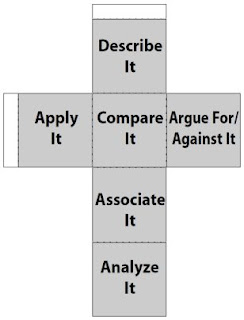Teacher asks what it means to have the “gist” of a topic. Discuss this, with examples.
Activities:
1. The teacher explains that the class will be working short text prompts using a literacy strategy that will help them be more successful in comprehending exactly what the point is.
2. Read a prompt together.
3. Learners take turns telling the teacher words that they find most essential. The teacher may list the words on a chart on the overhead or board. After the list of 5 -10 words is established, the students make suggestions to revise the list until the class comes to some consensus.
4. Read another prompt together. Learners now are asked to line out information that is not essential.
5. Students are given problems to work on their own or in small groups.
Wednesday, November 27, 2013
Cubing
Designed by G. E. Tompkins
Cubing is a literacy strategy which uses the concrete visual of a cube with its six sides to serve as a starting point for consideration of the multiple dimensions of topics within subject areas.
To introduce Cubing, start with a familiar topic and model the process. Then, assign more complex topics once learners have a grasp of how the process works. Learners examine the topic using the prompts from the six sides of the cube.
Describe it
If applicable, include color, shape, size.
How would you describe the issue/topic?
Compare it
What it is similar to or different from.
“It’s sort of like ______________________ .”
Associate it
What it makes you think of.
How does the topic connect to other issues/subjects?
Analyze it
Tell how it is made or what it is composed of.
How would you break the problem/issue into smaller
parts?
Apply it
Tell how it can be used.
How does it help you understand other topics/issues?
Argue for/against it
Take a stand and support it.
I am for this because __________________.
This works because ___________________ .
I agree because ______________________ .
Subscribe to:
Comments (Atom)

